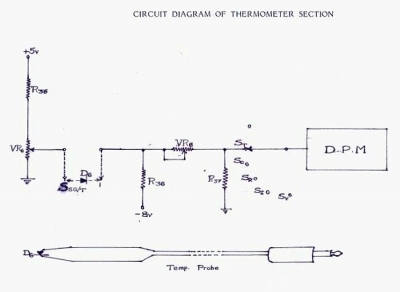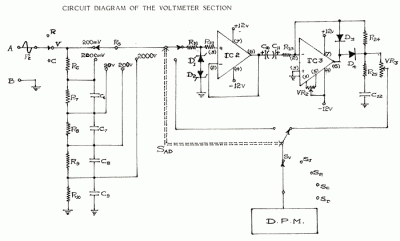
Test-Measurement

This project involved the development of a basic instrument capable of performing various tasks on a test bench. The cabinet utilized was part of a Hi-Fi DIY system, and the range and mode switches were modular stackable interlocked multipole switches. The remaining interface components included wirewound potentiometers, jacks, sockets, and plugs. The front panel was made of engraved acrylic, which presented a significant challenge in achieving a well-engineered aesthetic. The instrument was entirely analog, except for the digital indication provided by the ICL7107. The ICL7107 served as a digital panel meter, widely regarded as a reliable digital readout chip prior to the advent of low-power microcontroller designs. It remains a straightforward solution for displaying analog parameters in instruments. A 3.5-digit display provides sufficient resolution for recording process data or troubleshooting equipment, while a 4.5-digit display can reveal issues related to thermoelectric EMF generated by probes and connectors, which is one reason gold plating is employed to reduce contact resistance. In a 4.5-digit display, readings can also fluctuate due to contact resistance if the input impedance of the analog signal conditioning is not appropriately managed. Additionally, this project included a 20 Tera Ohm insulation tester developed approximately 20 years ago, featuring a polarization index for transformer insulation. It generated a regulated 1000V DC voltage and measured picoampere (pA) leakage current. The insulation tester applies a regulated, low-ripple high voltage with very low current capability to a device under test (DUT), measuring the leakage current in nanoamps or picoamps. An innovation in this design involved measuring the current in the reference voltage (Vref) rather than the input voltage (Vin) of the ICL7107, facilitating a 1/x computation. Furthermore, a psophometer was developed, which functioned as a true RMS auto-ranging AC dB level meter with weighted filters that mimic the audio response curve of the human ear. By integrating a built-in signal generator with dB settings, it effectively operated as a transmission measuring set.
The instrument design features a robust cabinet sourced from a Hi-Fi DIY system, ensuring durability and aesthetic appeal. The modular stackable interlocked multipole switches provide flexibility in selecting different ranges and modes, accommodating various test scenarios. Wirewound potentiometers are employed for precise adjustments, while jacks, sockets, and plugs facilitate easy connections to external devices. The engraved acrylic front panel not only enhances the visual appeal but also ensures user-friendliness by clearly displaying controls and indicators.
Incorporating the ICL7107 as the digital readout component allows for accurate and reliable measurements of analog signals. This chip is known for its effectiveness in converting analog voltage levels into readable digital formats, making it an ideal choice for this application. The choice of a 3.5-digit display balances resolution and simplicity, while the potential for a 4.5-digit display addresses the need for higher precision in certain applications, particularly in troubleshooting scenarios where small variations in readings can indicate significant issues.
The insulation tester represents a significant advancement in high-voltage testing equipment, with its capability to generate a regulated 1000V DC output. The measurement of leakage currents in the picoampere range is critical for assessing the integrity of insulation in transformers and other high-voltage devices. The innovative approach of measuring the reference voltage rather than the input voltage enhances measurement accuracy and reliability, providing a clearer understanding of the insulation condition.
The psophometer, with its true RMS capability and weighted filters, is tailored for audio applications, ensuring that measurements align closely with human auditory perception. The inclusion of a built-in signal generator allows for comprehensive testing and analysis of audio equipment, making this instrument versatile for both laboratory and field applications. Overall, this project exemplifies a thoughtful integration of analog and digital technologies to create multifunctional testing instruments.This was a Student Project of mine, it is a very basic instruments that could do most of the tasks on a test bench. The cabinet used, was available as a part of a Hi-Fi DIY System, The Range and Mode switches were Modular Stackable Interlocked MultiPole Switches.
The rest of the Interface were wirewound pots, jacks, sockets and plugs. The front pa nel was Engraved Acrylic, the panel was the toughest issue we tackled. I wanted it to look well engineered, at least on the outside. It was a total analog instrument except for the digital indication of ICL7107. Thanks Read More This is a Digital Panel Meter based on ICL7107. This was the workhorse Digital Readout chip before Low power uC designs were developed. Even now it is the easiest way an analog parameter can be displayed in an instrument. 3-1/2 Display is just enough resolution for recording process data or troubleshooting equipment. With 4-1/2 you notice the problems of thermoelectric EMF of probes and connectors. That is one reason gold plating is used another being low contact resistance. In 4 1/2 the reading can change due to contact resistance too, if the input impedance of the analog signal conditioning is Read More This is a 20 Tera Ohm Insulation Tester I made around 20 Years Back. It had even Polarization Index for Transformer Insulation. It generated 1000V DC Regulated Voltage and the pA leakage Current was Measured. See more here Insulation tester or Tera ohm meter. A regulated, low ripple, high voltage of very low current capability is applied by instrument on a DUT (device under test).
The leakage current in nA or pA (picoamps, nanoamps) is measured and readout, The Innovation i did was to measure the current in Vref and not Vin of ICL7107, this made the 1/x computation. Also Read More The one above was also made at TMPL, it is a Psophometer which was a true RMS auto-ranging AC dB level meter with weighted filters.
The weighted filter has to resemble the audio response curve of the ear. With a built in signal generator in dB settings it becomes a Transmission Measuring Set. This was in the eighties, it is similar to this Transmission Measuring Set from Aplab, this was the only relevant link i got. I also remember that aplab also had submitted a sample of a bigger unit then. Then some nice European units also were being evaluated Read More 🔗 External reference
The instrument design features a robust cabinet sourced from a Hi-Fi DIY system, ensuring durability and aesthetic appeal. The modular stackable interlocked multipole switches provide flexibility in selecting different ranges and modes, accommodating various test scenarios. Wirewound potentiometers are employed for precise adjustments, while jacks, sockets, and plugs facilitate easy connections to external devices. The engraved acrylic front panel not only enhances the visual appeal but also ensures user-friendliness by clearly displaying controls and indicators.
Incorporating the ICL7107 as the digital readout component allows for accurate and reliable measurements of analog signals. This chip is known for its effectiveness in converting analog voltage levels into readable digital formats, making it an ideal choice for this application. The choice of a 3.5-digit display balances resolution and simplicity, while the potential for a 4.5-digit display addresses the need for higher precision in certain applications, particularly in troubleshooting scenarios where small variations in readings can indicate significant issues.
The insulation tester represents a significant advancement in high-voltage testing equipment, with its capability to generate a regulated 1000V DC output. The measurement of leakage currents in the picoampere range is critical for assessing the integrity of insulation in transformers and other high-voltage devices. The innovative approach of measuring the reference voltage rather than the input voltage enhances measurement accuracy and reliability, providing a clearer understanding of the insulation condition.
The psophometer, with its true RMS capability and weighted filters, is tailored for audio applications, ensuring that measurements align closely with human auditory perception. The inclusion of a built-in signal generator allows for comprehensive testing and analysis of audio equipment, making this instrument versatile for both laboratory and field applications. Overall, this project exemplifies a thoughtful integration of analog and digital technologies to create multifunctional testing instruments.This was a Student Project of mine, it is a very basic instruments that could do most of the tasks on a test bench. The cabinet used, was available as a part of a Hi-Fi DIY System, The Range and Mode switches were Modular Stackable Interlocked MultiPole Switches.
The rest of the Interface were wirewound pots, jacks, sockets and plugs. The front pa nel was Engraved Acrylic, the panel was the toughest issue we tackled. I wanted it to look well engineered, at least on the outside. It was a total analog instrument except for the digital indication of ICL7107. Thanks Read More This is a Digital Panel Meter based on ICL7107. This was the workhorse Digital Readout chip before Low power uC designs were developed. Even now it is the easiest way an analog parameter can be displayed in an instrument. 3-1/2 Display is just enough resolution for recording process data or troubleshooting equipment. With 4-1/2 you notice the problems of thermoelectric EMF of probes and connectors. That is one reason gold plating is used another being low contact resistance. In 4 1/2 the reading can change due to contact resistance too, if the input impedance of the analog signal conditioning is Read More This is a 20 Tera Ohm Insulation Tester I made around 20 Years Back. It had even Polarization Index for Transformer Insulation. It generated 1000V DC Regulated Voltage and the pA leakage Current was Measured. See more here Insulation tester or Tera ohm meter. A regulated, low ripple, high voltage of very low current capability is applied by instrument on a DUT (device under test).
The leakage current in nA or pA (picoamps, nanoamps) is measured and readout, The Innovation i did was to measure the current in Vref and not Vin of ICL7107, this made the 1/x computation. Also Read More The one above was also made at TMPL, it is a Psophometer which was a true RMS auto-ranging AC dB level meter with weighted filters.
The weighted filter has to resemble the audio response curve of the ear. With a built in signal generator in dB settings it becomes a Transmission Measuring Set. This was in the eighties, it is similar to this Transmission Measuring Set from Aplab, this was the only relevant link i got. I also remember that aplab also had submitted a sample of a bigger unit then. Then some nice European units also were being evaluated Read More 🔗 External reference
